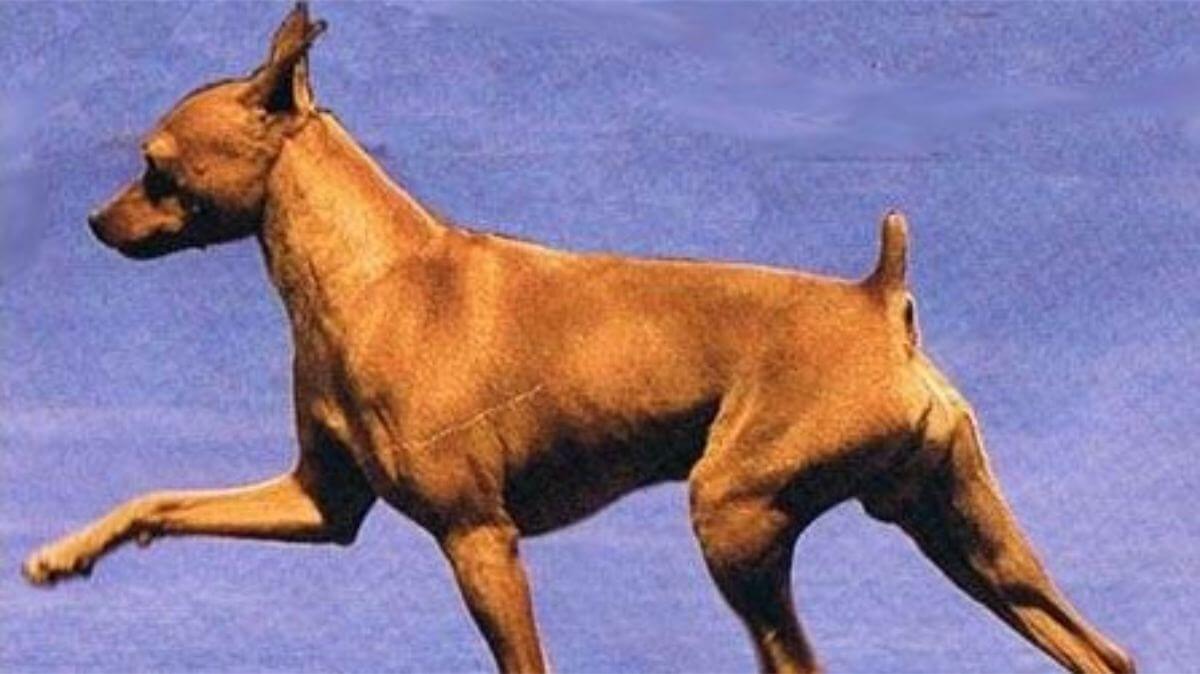


Home » Judging the Miniature Pinscher

So, you want to judge Miniature Pinschers!? Many believe that “hackney” is the only thing to know about Min Pins. They also think Min Pins are ditzy and hyperactive! They are high-energy, but that’s not the same as “hyper.” Successful breeder-judges like me will tell you there’s a great deal more to this remarkable breed! By the way, they are not bred-down Dobermans but are, in fact, a much older breed from the German Pinscher family.
The most important factor in judging the breed is the overall package. Surprised? You shouldn’t be. Breed type includes outline, balance, movement, correct structure, and soundness. The all-important proper temperament, combined with breed type, makes the Min Pin a unique and wonderful breed. Hackney-like gait is significant and a hallmark, but is not the only consideration in judging, as some think.
Min Pins are the “King of Toys.” In the ring, they must look and act like aristocrats. A well-balanced, smart, sleek, square dog, all parts gracefully flow together; the well-proportioned head, nicely arched neck blending smoothly into the shoulders, the level or slightly sloping topline, with level croup and high tailset in a muscular, wedge-shaped body combine to form a beautiful picture. Equally important are alertness, spirited presence, and self-possession.
The head must fit the body. From the front, the head appears narrow and tapering. The skull is flat. The foreface is strong with a slight but definite stop. There is a definite underjaw. Eyes are full, slightly oval, clear, bright, and dark. Nose is black, except in chocolates. The teeth meet in a scissors bite. One or two teeth slightly out of line should not be penalized if the bite is otherwise correct.
These little livewires often don’t stand like statues on the table or the ground. Never judge them on the table. Judge them on the ground, and use the table only for a quick examination to check bite, testicles on males, eye color, and for disqualifications. As this is a short-haired, single-coated breed, their physical traits and condition are easy to evaluate with a bare minimum of touching, prodding, and poking. What you see is what you get! Dogs and handlers are grateful if table time is kept brief! Don’t fault Min Pins for moving or wiggling on the table. Standing still on the table (or not) has nothing to do with quality and should not influence your placements.
Very important: DO NOT FORCE THE SINGLE ENTRY RIGHT UP ON THE TABLE! Just as you send a class of five around the ring once before tabling, the singleton should be granted the same courtesy. This is only fair. It relaxes the dog, and contrary to what some believe, takes no extra time.
On the ground, many Min Pins are easily distracted and don’t stand still for long. I don’t care if they stand perfectly in a row like little toy soldiers facing the same direction. However, I want to see them “show off.” They may do this by baiting for the handler, watching a dog in the next ring, watching a bird or butterfly at an outdoor show, or whatever else catches their eye! They are active and curious, but tend to have a short attention span. Not knowing what they will do next is part of their charm. Don’t be annoyed by their behavior; relax and learn to enjoy their antics! Also remember, Min Pins are not hand-stacked on the ground; they should be taught to show themselves. If handlers are down and hand-stacking, ask them to stand and allow the dog to show off.
Min Pins often stop and shake at least once when moving. They should gait with head and tail up. Ears do not have to be up while moving. Some exhibitors string up the dog tightly in an effort to hide a poor front or in the mistaken belief that the dog will have better front action. Don’t hesitate to ask for a loose lead. A Min Pin moving out smartly ahead of the handler is delightful, but this is “icing on the cake” and not all of them can or will do this. A Min Pin who “slinks” around the ring or moves with tail down should NEVER be rewarded. This is an indication of poor temperament and must be discouraged. Remember, the Standard calls for “fearless animation” and “complete self-possession.” Puppies may be a little unsure of themselves, but never fearful. Adults MUST have that “Look at Me” attitude.
The correct hackney-like action causes a lot of confusion. The Breed Standard describes it as a “high stepping, reaching, free and easy gait in which the front leg moves straight forward and in front of the body and the foot bends at the wrist. The dog drives smoothly and strongly from the rear.” This is a good description. Note: The Standard does not call for extremely high leg lift. In fact, dogs with exaggerated front action usually exhibit unacceptable traits when seen straight on, such as out at the elbow, crossing over, or “mix-masters.”
The high-stepping front action occurs because of the moderately angled front and slightly more angulated rear of a properly built Min Pin. The pasterns are flexible enough to allow the wrist to bend.
The hackney-like action is described for FRONT legs only. The rear should not lift. The Standard states: “The dog drives smoothly and strongly from the rear.” The side gait is correct if the dog moves in a straight line with good rear drive, front reach, and extension with the pastern bending before the foot comes down. The amount of lift and bend may vary greatly from dog to dog. Lift and bend are called for, but there is no requirement as to how high the lift or how much bend! Remember, if the leg lifts and bends, it is correct. The degree or amount of lift and bend is unimportant.
While flashy front movement may be dazzling, it’s NOT ENOUGH. Min Pins must also have breed type, be sound coming and going, and have strong rear drive.
The Min Pin must be between 10 and 12½ inches at the highest point of the shoulder, with disqualifications under and over these limits. All dogs within this height range should be judged equally. If a 10-inch dog and a 12½-inch bitch have the best conformation and movement, they should be rewarded. The Standard makes no distinction between genders, except that bitches may be slightly longer than dogs. Height and muscle do not differ for dogs and bitches. If there is any question about height, please measure the dog. The exhibitors will appreciate this far more than putting a dog at the end of the line because you “think” it looks too big or too small.
All colors must be judged equally. Min Pins may be solid clear red, ranging from dark mahogany to light red. Stag is a red base coat with an intermingling or overlay of black hairs. Amount and placement of black hairs is not important. Red Min Pins may have lighter shading or “bisking” on the neck, over the shoulder blades, and near the vent region. This is perfectly acceptable and should not be penalized. Black with rust-red markings and Chocolate with rust-red markings are often at a disadvantage because the broken colors create an optical illusion and may make the dogs APPEAR to be built differently than their red counterparts. You must be careful to examine and assess them fairly. The Standard describes correct markings and states a preference for rich, vibrant, medium to dark shades on the Reds. However, color and/or markings must never take precedence over conformation and soundness.
About “man-made” faults: Min Pins may be shown with natural or cropped ears as long as the ears are erect. Give equal consideration to both. Some ear crops are unattractive; i.e., short and wide, uneven lengths. This is man-made and should not be used to fault the dog. This is true for tails docked too short or too long. Tail set and carriage are important, length is not.
White exceeding ½ inch in its longest dimension is a disqualification, but a scattering of white hairs or “frost” on the chest is a deviation, not a DQ.
Thumb marks, a patch or island of black (or chocolate) hair, completely surrounded by rust-red on the front of the foreleg is a DQ.
In summary, judge the WHOLE dog, reward the virtues, penalize faults to the extent of the deviation from ideal, and don’t make Min Pins one-dimensional by looking only at side gait!